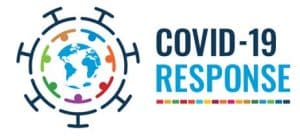New UN websites & publications
UN in General
United Nations Secretary-General’s SDG Stimulus to Deliver Agenda 2030 (February 2023)
https://www.un.org/sustainabledevelopment/wp-content/uploads/2023/02/SDG-Stimulus-to-Deliver-Agenda-2030.pdf
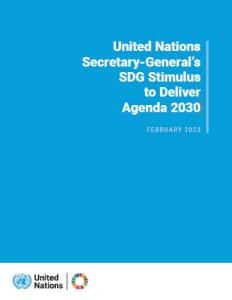
see also: Guterres calls for G20 to agree $500 billion annual stimulus for sustainable development (UN News, 17 February 2023): https://news.un.org/en/story/2023/02/1133637
Building blocks out of crisis – The UN’s SDG Stimulus Plan (UNDP Development Series)
https://www.undp.org/publications/dfs-building-blocks-out-crisis-uns-sdg-stimulus-plan
Developing economies could secure hundreds of billions of dollars in savings if the world commits to restructuring their existing debt and expanding access to future affordable finance, according to a new policy brief published on 22 February 2023 by the United Nations Development Programme (UNDP). The brief identifies 52 low and middle-income developing economies either in debt distress or at high risk of debt distress, accounting for more than 40 percent of the world’s poorest people. It shows how a 30 percent haircut on their public external debt stock in 2021 could help save up to $148 billion in debt service payments over eight years. The policy brief outlines the urgent policy steps needed to reverse the current debt crisis and shows the potentially transformative impact of dealing with debt and expanding access to lower cost and long-term maturity funding – two of the focus areas outlined in the UN Secretary General’s SDG Stimulus Plan released last week. The plan outlines the need for the international community to come together to mobilize investments for the Sustainable Development Goals (SDGs) and proposes three areas for immediate action: injecting liquidity, restructuring sovereign debt, and lowering the cost of long-term lending to developing economies.
Our Common Agenda – Policy Briefs
English: https://www.un.org/en/common-agenda/policy-briefs
French: https://www.un.org/fr/common-agenda/policy-briefs
Spanish: https://www.un.org/es/common-agenda/policy-briefs
Throughout this year, the Secretariat will issue a series of 11 policy briefs with concrete ideas for your consideration. The proposals in the briefs will be strongly linked to the Sustainable Development Goals, responding to your observations during the five thematic consultations last year.
see: Today We Must Begin ‘Moving Recommendations in Our Common Agenda from Ideas to Action — from Abstract to Concrete’, Secretary-General Tells General Assembly (SG/SM/21686, 13 February 2023): https://press.un.org/en/2023/sgsm21686.doc.htm
Our Common Agenda: Policy brief 1: to think and act for future generations (A/77/CRP.1, 7 February 2023)
English, French & Spanish: https://undocs.org/A/77/CRP.1
“Summary: … The present policy brief contains suggestions for practical steps to fulfil our long-standing commitment to meet the demands of the present in a way that safeguards the interests of future generations and preserves their ability to effectively enjoy all human rights. These include: (a) an envoy to serve as a voice for future generations at the global level; (b) better use of foresight, science and data; (c) a declaration to define and make concrete our duties to future generations; and (d) a dedicated intergovernmental forum to advance implementation of the declaration and share best practices. …”
Our Common Agenda: Policy brief 2: strengthening the international response to complex global shocks – an Emergency Platform (A/77/CRP.1/ADD.1, 15 February 2023)
English, French & Spanish: https://undocs.org/A/77/CRP.1/ADD.1
“Summary: … The present policy brief aims to elaborate on the proposal on the Emergency Platform to respond to complex global shocks, incorporating feedback received from Member States and other relevant partners. The Emergency Platform would not be a standing body or entity but a set of protocols that could be activated when needed. The brief outlines some of the characteristics of global shocks in the twenty-first century and some of the risks we could face in the future. It highlights how such shocks have the potential to undermine progress to achieving the Sustainable Development Goals and 2030 Agenda, as well as human rights and gender equality. It reflects on lessons from the response to recent complex global shocks and sets out proposals to strengthen the international response to a complex, global shock through the convening of an Emergency Platform. Finally, it offers recommendations on how these proposals could be taken forward in the Pact for the Future. …”
Multilingualism at the United Nations
six official languages: https://www.un.org/en/library/whyitmatters
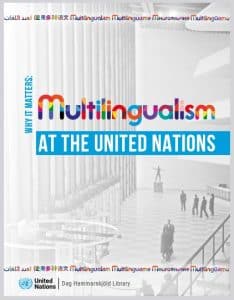
Countering disinformation – new website
English: https://www.un.org/en/countering-disinformation
French: https://www.un.org/fr/countering-disinformation
Spanish: https://www.un.org/es/countering-disinformation
Rapid technical transformations have completely upended the ways people interact, communicate and access information. Yet these dramatic shifts have also had negative consequences, including the much-accelerated rate at which misinformation, disinformation, and even hate speech spread. In his report, Countering disinformation for the promotion and protection of human rights and fundamental freedoms, the Secretary-General describes the challenges posed by disinformation, as well as the response that States and technology enterprises reported to have taken to counter it. Disinformation can affect a broad range of human rights, undermining responses to public policies or amplifying tensions in times of emergency or armed conflict.
see also: UNRIC Library Backgrounder “Combat Misinformation – Selected Online Resources on Misinformation, Disinformation and Hate Speech” – https://unric.org/en/unric-library-backgrounder-combat-misinformation/
Coronavirus Disease (COVID-19)
A clinical case definition for post COVID-19 condition in children and adolescents by expert consensus (16 February 2023)
https://www.who.int/publications/i/item/WHO-2019-nCoV-Post-COVID-19-condition-CA-Clinical-case-definition-2023-1

Collapse and Recovery: How Covid-19 Eroded Human Capital and What to Do About It (World Bank)
https://openknowledge.worldbank.org/handle/10986/39403

Inequality in Access to Essential Health and Medicine: COVID-19 Vaccines (UNDP)
https://www.undp.org/publications/inequality-access-essential-health-and-medicine-covid19-vaccines
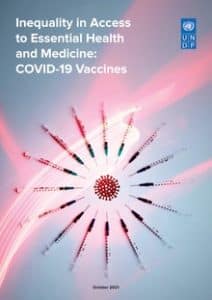
Inter-Agency Humanitarian Evaluation COVID-19
https://interagencystandingcommittee.org/inter-agency-humanitarian-evaluations/inter-agency-humanitarian-evaluation-covid-19
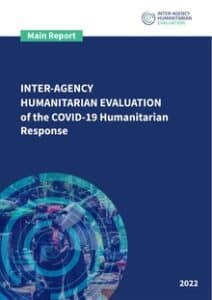
The IAHE finds that despite being already severely overstretched, the humanitarian community expanded and adapted its programming to meet the needs of a vastly larger humanitarian caseload and provide a safety net for millions of people who would otherwise have gone without assistance. While international humanitarian actors rose to the occasion, the level of worldwide restrictions on international aid underscored the opportunity costs of humanitarian actors not having advanced long-sought reforms, particularly for more locally led humanitarian action and strengthening accountability to affected people. Greater progress in these important areas would have helped the COVID-19 humanitarian response to meet the needs of all vulnerable people more appropriately; expand the available capacities to deliver; more adequately prevent the risks of sexual exploitation and abuse and address the trust deficit with affected communities, which was so essential to the promotion of healthy behaviors to contain the pandemic.
Despite many hopes raised by the crises, the report finds that the main challenge to advancing some of the high-potential agendas was not a lack of knowledge or understanding but a lack of leadership, incentives, and commitments on behalf of major players to make changes to the current aid architecture. Drawing lessons learned from the pandemic, the IAHE report formulates several recommendations to the IASC, focusing on accelerating humanitarian reforms and improving preparedness for the next pandemic.
Inter-Agency Humanitarian Evaluation COVID-19, Learning Paper on GHRP
https://interagencystandingcommittee.org/inter-agency-humanitarian-evaluations/inter-agency-humanitarian-evaluation-covid-19-learning-paper-ghrp
Inter-Agency Humanitarian Evaluation COVID-19, Learning Paper on Localization
https://interagencystandingcommittee.org/inter-agency-humanitarian-evaluations/inter-agency-humanitarian-evaluation-covid-19-learning-paper-localization-0
Economic Growth and Sustainable Development
The 2023 Climate Risk Landscape (UNEP)
https://www.unepfi.org/themes/climate-change/2023-climate-risk-landscape/
The past few years have demonstrated a remarkable level of volatility. Efforts to establish a “new normal” after the COVID-19 pandemic were interrupted by the Russian invasion of Ukraine, and a wave of food and energy crisis. Central bankers have continued to raise interest rates to tame inflation, ending the “lower for longer” regime that has persisted since the Global Financial Crisis. Amid these changes, societies must contend with the worsening effects of human-caused climate change and the critical economic transition to a net-zero emissions future. The impacts of climate change and the necessary transition will impact almost every human and natural system. Successful companies and communities will be ones that are resilient in the face of these challenges. UNEP FI’s 2023 Climate Risk Landscape report aims to assist financial actors in better understanding this diverse and dynamic landscape of climate risk tools. The report explores the major market trends in both physical risk and transition risk tools and provides detailed analysis on dozens of individual tools. Some of the key findings found within the report are as follows: Greater integration of different climate risks within tools, Focus on net-zero commitments within tools, Rising regulatory demands are accelerating tool use and functionality, New data and new insights are top priorities for financial institutions.
Boreal Forests and Climate Change: From Impacts to Adaptation; Policy Brief (UNECE)
https://unece.org/info/Forests/pub/376094
Boreal forests are finally making the news. Also referred to as snow forests and taiga, they are the world’s largest land ecozone, spanning over Canada, China, Finland, Japan, Norway, Russian Federation, Sweden and the United States and constitute one of the planet’s largest carbon sinks, holding 20% of the world’s carbon emissions. According to the International Boreal Forest Research Association (IBFRA), they represent about 30% of the global forest area, with more surface freshwater than any other biome, and large tracts of unmanaged forests. But their essential role in regulating the global climate which has gone unnoticed for many years is under threat. Therefore, it has never been more urgent to understand the boreal forest ecosystems in a changing climate, as well as their special place as a much-needed asset of our universal climate mitigation and adaptation efforts. UNECE’s latest policy brief underscores this urgent need for action to increase the resilience and adaptation of boreal forests to possible climate change scenarios.
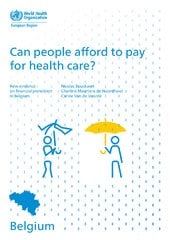
https://www.who.int/europe/publications/i/item/9789289058599
The share of households with catastrophic health spending in Belgium is currently among the highest in western Europe, according to a new report launched on 28 February 2023 by the WHO Regional Office for Europe. However, concrete steps are being taken to address this challenge – one that is shared by many other countries in the WHO European Region. Catastrophic health spending means a household can no longer afford to meet basic needs – food, housing and heating – because of having to pay out of pocket for health care. According to the report, nearly 260 000 households in Belgium experienced catastrophic health spending in 2020, the latest year of data available. This corresponds to 5.2% of all households, but the number goes up to 8% for households headed by unemployed people and 12% for households in the poorest fifth of the population. Produced in collaboration with the Belgian Health Care Knowledge Centre (KCE), and with funding from the European Union (EU), the new analysis shows that catastrophic health spending in Belgium is more heavily driven by out-of-pocket payments for medical products (for example, hearing aids, glasses, dentures and prostheses) than in many other countries. For poorer households, it is mainly driven by outpatient medicines, diagnostic tests and outpatient care.
Estimate of Total Methane Emissions from the Nord Stream Gas Leak Incident – Draft Working Paper (UNEP)
https://wedocs.unep.org/20.500.11822/41838
The United Nations Environment Programme (UNEP) conducted an analysis on the magnitude of methane leaked following the incident on the Nord Stream natural gas pipelines, in the Baltic Sea, last September. The analysis, produced by UNEP’s International Methane Emissions Observatory (IMEO) – an initiative that drives action on methane – estimates the plausible range of total methane emissions leaked during the incident as 75-230 kt. In this document, UNEP synthesised estimates of the Nord Stream leak produced by several research organisations. It then integrated them with the only in-situ measurements performed by the German Aerospace Center (DLR), as commissioned by IMEO. This analysis contributes to closing the knowledge gap on how important methane emissions are and where they are emitted across the planet. It also reduces uncertainty associated with the methane leak.
see also: UNEP finds Nord Stream gas leak may be the highest methane emission event, but still a drop in the ocean (20 February 2023): https://www.unep.org/technical-highlight/unep-finds-nord-stream-gas-leak-may-be-highest-methane-emission-event-still
‘Filling the Void’: Engaging Indigenous Peoples in Arctic Environmental Governance (UNU-CRIS)
https://cris.unu.edu/engaging-indigenous-peoples-arctic-environmental-governance
This policy brief contributes to the understanding of the roles of Indigenous Peoples’ Organisations in the context-specific environmental governance challenges in the Arctic Region, and as a reference for designing long-term solutions and for advancing understanding and capacity for researchers and practitioners interested in the region through better and up-to-date knowledge. The narratives presented in this policy brief also reflect gaps and needs in the existing Arctic environmental governance mechanisms, providing an overview of the existing modalities but demonstrating their limited or fragmented operational scope. We also examine how the global agreements, institutions, and policies on environmental governance in this region provide a platform for global, regional, national, and inter-agency cooperation processes and policies.

https://www.fao.org/documents/card/en/c/cc3981en
Improving management practices in grasslands— large areas covered with grass, especially used for animal grazing— can boost the capacity of soils as carbon sinks, and help countries reach their climate goals, according to a new report by the Food and Agriculture Organization of the United Nations (FAO) released on 14 February 2023. After oceans, soils are the second largest carbon pool on Earth and they play an important role in global climate change due to the large amount of carbon currently stored in soil organic matter. The first FAO Global assessment of Soil Carbon in Grasslands measured the baseline of stocks of Soil Organic Carbon (SOC) — the carbon held within the soil that is measurable, expressed as a percentage by weight (gC/Kg soil)— in both semi-natural and managed grasslands and estimated their potential of SOC sequestration. The study found that if the SOC content in the 0–30 cm depth layer of available grasslands increased by 0.3 per cent after 20 years of the application of management practices that enhance soil organic carbon sequestration, 0.3 tonnes C/ha per year could be sequestered.
Glossary for Inland Water Transport (UNECE)
https://unece.org/info/Transport/Inland-Water-Transport/pub/375692
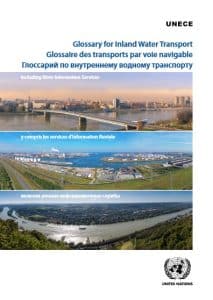
Growing Challenges for Sustainable Development: Can the UNECE Region Turn the Tide in 2023?
https://w3.unece.org/sdg2023/
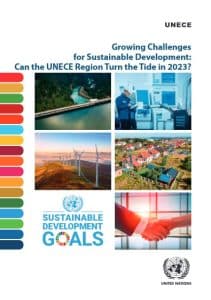
Igniting SDG Progress Through Digital Financial Inclusion: 2023 Edition
https://data.unhcr.org/en/documents/details/98816
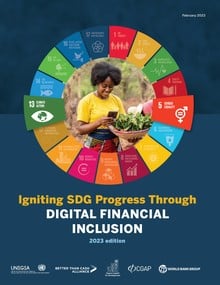
This compendium is a collaboration between the Office of the United Nations Secretary-General’s Special Advocate for Inclusive Finance for Development (Her Majesty Queen Máxima of the Netherlands), the United Nations-based Better Than Cash Alliance, the United Nations Capital Development Fund, the Consultative Group to Assist the Poor (CGAP) and the World Bank.
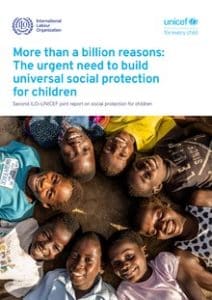
https://www.unicef.org/documents/urgent-need-for-universal-social-protection
The number of children without access to social protection is increasing year-on-year, leaving them at risk of poverty, hunger and discrimination, according to a new report released by the International Labour Organization (ILO) and UNICEF on 1 March 2023. The report warns that an additional 50 million children aged 0-15 missed out on a critical social protection provision – specifically, child benefits (paid in cash or tax credits) – between 2016 and 2020, driving up the total to 1.46 billion children under 15 globally. … The report emphasizes that all countries, irrespective of their level of development, have a choice: whether to pursue a “high-road” strategy of investment in reinforcing social protection systems, or a “low-road” strategy that misses out on necessary investments and will leave millions of children behind.
New data shine light on gender gaps in the labour market (ILO)
https://www.ilo.org/global/statistics-and-databases/publications/WCMS_870519/lang–en/index.htm
Gender imbalances in access to employment and working conditions are greater than previously thought and progress in reducing them has been disappointingly slow in the last two decades, according to a new ILO brief. A new indicator developed by the International Labour Organization (ILO), the Jobs Gap, captures all persons without employment that are interested in finding a job. It paints a much bleaker picture of the situation of women in the world of work than the more commonly used unemployment rate. The new data shows that women still have a much harder time finding a job than men. According to the brief, 15 per cent of working-age women globally would like to work but do not have a job, compared with 10.5 per cent of men. This gender gap has remained almost unchanged for two decades (2005-2022). In contrast, the global unemployment rates for women and men are very similar, because the criteria used to define unemployment tends to disproportionately exclude women.
One Year Later: What Lessons should Policymakers and Scholars From the EU Draw From Russia’s Invasion of Ukraine? (UNU-CRIS)
https://cris.unu.edu/one-year-later-lessons-from-Russian-invasion-of-Ukraine
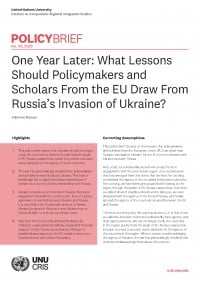
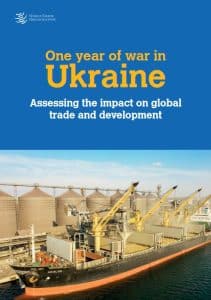
https://www.wto.org/english/res_e/booksp_e/oneyukr_e.pdf
A new WTO information note released on 23 February reports that global trade remained resilient and performed better than pessimistic predictions for 2022 as economies greatly affected by the war in Ukraine found alternative sources of supply. For the longer-term outlook, new WTO simulations show the importance of strengthening the multilateral trading system, with least-developed countries likely to be hardest hit if international cooperation were to break down. The note estimates that trade growth in 2022 was above the WTO trade forecast of 3% issued in April and substantially higher than its estimates for more pessimistic scenarios for the year. The stability of global trade was also evident in global supply chains, confirmed by the 4% year-on-year growth of trade in intermediate goods in the second quarter of 2022.
Status report on prison health in the WHO European Region 2022
https://www.who.int/europe/publications/i/item/9789289058674
WHO/Europe launched on 15 February 2023 its second “Status report on prison health in the WHO European Region” at an event hosted by the Portuguese Government. The report provides an overview of the performance of prison health systems in the Region based on survey data from 36 countries. The data shows that the response of countries to COVID-19 in prisons was generally good, however, it also highlights areas of concern, including overcrowding and a lack of services for mental health, which represents the greatest health need among people in prison across the Region.

https://bit.ly/3KnQTah
In the European Union (EU), 45% of people say they never exercise or play sport, and every third person has insufficient levels of physical activity, according to the latest specific Eurobarometer survey. This leads to millions of cases of noncommunicable diseases (NCDs) that ruin people’s health and burden economies. A new report from WHO and the Organisation for Economic Co-operation and Development (OECD) – “Step up! Tackling the burden of insufficient physical activity in Europe” – explains how increasing physical activity to the recommended levels could prevent thousands of premature deaths in the EU and save billions in health-care spending.
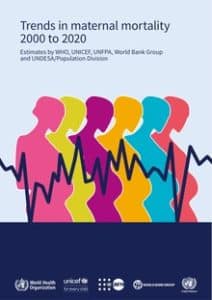
https://www.who.int/publications/i/item/9789240068759
Every two minutes, a woman dies during pregnancy or childbirth, according to the latest estimates released in a report by United Nations (UN) agencies on 23 February 2023. The report reveals alarming setbacks for women’s health over recent years, as maternal deaths either increased or stagnated in nearly all regions of the world. The report, which tracks maternal deaths nationally, regionally and globally from 2000 to 2020, shows there were an estimated 287 000 maternal deaths worldwide in 2020. This marks only a slight decrease from 309 000 in 2016 when the Sustainable Development Goals (SDGs) came into effect. While the report presents some significant progress in reducing maternal deaths between 2000 and 2015, gains largely stalled, or in some cases even reversed, after this point.
UNDP Action Brief: An Ocean of Opportunities – How the Blue Economy Can Transform Sustainable Development in Small Islands Developing States
https://www.undp.org/publications/action-brief-ocean-opportunities-how-blue-economy-can-transform-sustainable-development-small-islands-developing-states

UNDP Development Future Series: Synergies in Jointly Addressing Climate Change, Health Equity and Gender Equality
https://www.undp.org/publications/undp-development-future-series-synergies-jointly-addressing-climate-change-health-equity-and-gender-equality
Climate change is already impacting negatively on the health and well-being of individuals across the globe, and this burden is likely to become more important and debilitating over time. Due to deep-rooted systemic inequalities, the growing negative consequences disproportionately affect diverse women, girls and lesbian, gay, bisexual, transgender and intersex (LGBTI) people. The same structural and cultural factors that render them more vulnerable also limit their meaningful participation in mitigation and adaptation planning and marginalize their needs. This policy brief argues the case that to enable gender-transformative, intersectional and rights-based approaches, climate change, gender and other social determinants of health must therefore be considered and addressed jointly where possible. A systems-based approach can improve the understanding of important synergies and co-benefits, feedback loops, trade-offs and unanticipated consequences that are critical to priority-setting and effective responses. It can also foster critically needed cross-sectoral collaboration among the policymakers and advocates who work on climate, health and gender equality.
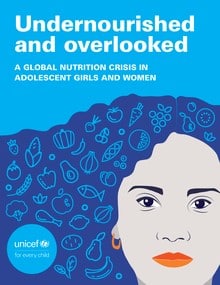
Report in English, Executive Summary in English, French & Spanish:
https://www.unicef.org/reports/undernourished-overlooked-nutrition-crisis
The number of pregnant and breastfeeding adolescent girls and women suffering from acute malnutrition has soared from 5.5 million to 6.9 million – or 25 per cent – since 2020 in 12 countries hardest hit by the global food and nutrition crisis, according to a new report released by UNICEF on 7 March 2023. The 12 countries – including Afghanistan, Burkina Faso, Chad, Ethiopia, Kenya, Mali, Niger, Nigeria, Somalia, South Sudan, Sudan and Yemen – represent the epicentre of a global nutrition crisis that has been exacerbated by the war in Ukraine and ongoing drought, conflict, and instability in some countries. The report – issued ahead of International Women’s Day – warns that the ongoing crises, aggravated by ongoing gender inequality, are deepening a nutrition crisis among adolescent girls and women that had already shown little improvement in the last two decades.

https://esaro.unfpa.org/en/publications/what-works-hiv-prevention-promising-practices-east-and-southern-africa
The elation that greeted the discovery of vaccines against COVID-19 in 2020 recalls the hope unleashed in the early 2000s when antiretrovirals (ARVs) became available worldwide at affordable prices. Neither of these two notable scientific breakthroughs is a silver bullet against the two viruses (HIV and SARS-CoV-2) but both help prevent death and disease. ARV treatment was a game changer. By 2015, the global mass cascading of ART allowed the United Nations to commit to ambitious targets. There is no time to lose if the region is to meet the 2025 targets for HIV prevention. With this goal, UNFPA has collected examples of successful interventions for HIV prevention in Botswana, Kenya, Malawi, Namibia and Uganda. Each section ends with a selection of evidence-based priority actions from the UNFPA East and Southern Africa Strategy to End HIV.
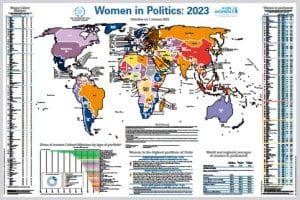
English & French, Spanish forthcoming: https://www.unwomen.org/en/digital-library/publications/2023/03/women-in-politics-map-2023
More women than ever hold political decision-making posts worldwide, but gender parity is still far off, according to the 2023 edition of the IPU-UN Women Map of Women in Politics. The map presents the latest rankings and regional distribution of women in executive positions and national parliaments as of 1 January 2023. The data shows that the number of women in political leadership roles, both in government and in parliament, has increased overall but some regions lag far behind.
International Peace and Security
Concept note for the Security Council open debate on the theme “Threats to international peace and security: sea-level rise – implications for international peace and security”
English, French & Spanish: https://undocs.org/S/2023/79
The Security Council held an open debate on 14 February 2023 on the theme “Sea-level rise – implications for international peace and security”, under the agenda item entitled “Threats to international peace and security”. Malta, the Security Council President for February 2023, has prepared this concept note.
Concept note for the Security Council briefing on the theme “Children and armed conflict: prevention of grave violations”
English, French & Spanish: https://undocs.org/S/2023/80
The Security Council held a briefing on 13 February 2023 on prevention, in connection with the item entitled “Children and armed conflict”. Malta, the Security Council President for February 2023, has prepared this concept note.
Concept note for the Security Council open debate on the theme “Women and peace and security: towards the twenty-fifth anniversary of resolution 1325 (2000)
English, French & Spanish: https://undocs.org/S/2023/146
Mozambique, in its capacity as President of the Security Council for the month of March 2023, held a ministerial open debate on the theme “Women and peace and security: towards the twenty-fifth anniversary of resolution 1325 (2000)”, on 7 March 2023. In order to guide the discussions, Mozambique has prepared this concept note.
Concept note for the Security Council high-level debate on the theme “Threats to international peace and security caused by terrorist acts: countering terrorism and preventing violent extremism conducive to terrorism by strengthening cooperation between the United Nations and regional organizations and mechanisms”
English, French & Spanish: https://undocs.org/S/2023/147
Mozambique, under its presidency of the Security Council for the month of March 2023, will hold a high-level debate on the theme “Threats to international peace and security caused by terrorist acts: countering terrorism and preventing violent extremism conducive to terrorism by strengthening cooperation between the United Nations and regional organizations and mechanisms”, on 28 March 2023. In order to guide the discussions, Mozambique has prepared this concept note.
Concept note for the Security Council open debate on the theme “Peace and security in Africa: the impact of development policies in the implementation of the Silencing the Guns initiative”
English, French & Spanish: https://undocs.org/S/2023/148
In its capacity as President of the Security Council for the month of March 2023, Mozambique will convene a Security Council open debate on the theme “Peace and security in Africa: the impact of development policies in the implementation of the Silencing the Guns initiative”, on 30 March 2023. In order to guide the discussions on the topic, Mozambique has prepared this concept note.
Human Rights

https://data.unicef.org/wp-content/uploads/2023/02/Included_Every_Step_of_the_Way.pdf
Children with disabilities and children on the move represent highly diverse populations living in a broad range of circumstances. But as two of the most marginalized groups of children in the world, there is much they have in common, often-times neglected in data collection, policies and programming. This report examines children’s lives when these two identities intersect. It asks key questions about growth, development, safety and security when children with disabilities migrate or have been displaced. While the available evidence is limited, it is clear that across contexts – from humanitarian to high-income settings – this group of children faces high barriers to participating in society.
The Population of Cité Soleil in the Grip of Gang Violence Investigative report on human rights abuses committed by gangs in the zone of Brooklyn from July to December 2022 (BINUH / OHCHR)
English & French: https://www.ohchr.org/en/documents/country-reports/population-cite-soleil-grip-gang-violence-investigative-report-human
Extreme violence and gross human rights abuses, including mass incidents of murder, gang rape and sniper attacks, have sharply increased in Cité Soleil on the outskirts of the Haitian capital, said a UN report published on 10 February 2023, creating “a living nightmare” for thousands. “The findings of this report are horrifying: it paints a picture of how people are being harassed and terrorized by criminal gangs for months without the State being able to stop it. It can only be described as a living nightmare,” Volker Türk, the UN High Commissioner for Human Rights, said. The report said that from 8 July to 31 December 2022 gang violence resulted in 263 murders in the Brooklyn neighbourhood of Cité Soleil, the impoverished and densely populated commune near the capital Port-au-Prince. It documented at least 57 gang rapes of women and girls, as well as kidnappings and sexual exploitation.
OHCHR Civic Space Briefs
- Hearing Civil Society Voices in Treaty Making: https://www.ohchr.org/sites/default/files/2023-02/Civic-space-treaty-making-InBrief-FINAL.pdf
- Civil Society Space and COVID-19:
https://www.ohchr.org/sites/default/files/2023-02/CIVIC-SPACE-InBrief-vs3.4.pdf
Humanitarian Affairs
Türkiye-Syria Earthquake Response
English: https://www.un.org/en/türkiye-syria-earthquake-response
French: https://www.un.org/fr/türkiye-syria-earthquake-response
Spanish: https://www.un.org/es/türkiye-syria-earthquake-response
The devastating 7.8-magnitude earthquake near the Türkiye-Syria border in the early hours of 6 February 2023 was followed by another one nearly as strong. The earthquakes that struck Türkiye and Syria caused one of the biggest disasters to impact the region. The United Nations and its agencies are deploying disaster assessment experts; coordinating search and rescue teams; providing emergency relief, food, medical supplies, thermal blankets and other life-saving items. UN convoys have crossed into northern Syria through the Bab al-Hawa crossing delivering shelter and relief supplies.
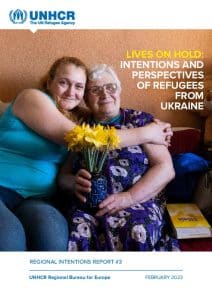
https://data.unhcr.org/en/documents/details/99072
Executive summary: Following the first and second regional intentions reports, this third report presents updated findings regarding intentions of refugees from Ukraine across Europe, in-depth analysis of the factors and drivers behind their decisions, and key insights into enabling factors of refugees’ intentions, with the goal of informing advocacy, programming and decision-making of all stakeholders. The analysis is based on a third round of UNHCR intentions surveys, conducted in partnership with Ipsos SA, with around 3,900 interviews undertaken between December 2022 and January 2023 in countries neighbouring Ukraine as well as other host countries in Europe, complemented with findings from focus group discussions. The analysis aims to answer four main questions: What are the household profiles and current socio-economic conditions of refugees which can influence their intentions? What are refugee’s intentions or plans in the short and the long term? What are the main reasons and drivers influencing refugees’ decisions and planning? What are the main enabling factors that could determine refugees’ intentions to return to Ukraine?

https://www.connectingbusiness.org/publications/ocha-business-brief-ukraine-humanitarian-crisis
The ongoing war in Ukraine has resulted in large-scale displacement, including refugee outflows, and a humanitarian crisis on a massive scale. Close to 16 million affected people inside of Ukraine and over 5 million refugees in neighbouring countries received assistance in 2022. Unfortunately needs are still great, and a total of 21.8 million people are expected to require humanitarian assistance in 2023. Since the war began, there has been an unprecedented outpouring of support from the private sector. In this updated Business Brief from the United Nations Office for the Coordination of Humanitarian Affairs (OCHA), learn more about how the private sector can help.
Post-quake Syrian Arab Republic: A wake-up call and a time for action (ESCWA Policy Brief)
https://www.unescwa.org/sites/default/files/news/docs/23-00172-syria_post_quake_policy_brief-en.pdf
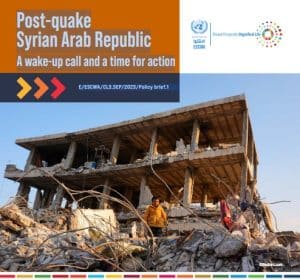
Justice and International Law
UN delegates reach historic agreement on protecting marine biodiversity in international waters
The agreement reached by delegates of the Intergovernmental Conference on Marine Biodiversity of Areas Beyond National Jurisdiction, better known by its acronym BBNJ, is the culmination of UN-facilitated talks that began in 2004.
English: https://news.un.org/en/story/2023/03/1134157
French: https://news.un.org/fr/story/2023/03/1132947
Spanish: https://news.un.org/es/story/2023/03/1519102
see also: Draft agreement under the United Nations Convention on the Law of the Sea on the conservation and sustainable use of marine biological diversity of areas beyond national jurisdiction (advanced, unedited)
PDF: https://www.un.org/bbnj/sites/www.un.org.bbnj/files/draft_agreement_advanced_unedited_for_posting_v1.pdf
WORD: https://www.un.org/bbnj/sites/www.un.org.bbnj/files/draft_agreement_advanced_unedited_for_posting_v1.docx
Nuclear, Chemical and Conventional Weapons Disarmament
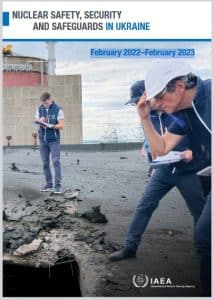
https://www.iaea.org/sites/default/files/23/02/nuclear-safety-security-and-safeguards-in-ukraine-feb-2023.pdf
The International Atomic Energy Agency (IAEA) issued a report on 23 February 2023 on Nuclear Safety, Security and Safeguards in Ukraine, covering the period between February 2022 and February 2023. The 52-page report provides an overview of the situation and the IAEA’s activities to reduce the likelihood of a nuclear accident during the armed conflict. The report also gives an overview of relevant aspects of the implementation of safeguards under the current circumstances in Ukraine.
Drug Control, Crime Prevention and Counter-terrorism

https://www.unodc.org/documents/data-and-analysis/toc/Haiti_assessment_UNODC.pdf
Increasingly sophisticated and high-calibre firearms and ammunition are being trafficked into crisis-hit Haiti, according to a new assessment released on 2 March 2023 by the United Nations Office on Drugs and Crime (UNODC). Gang-related violence in Haiti has reached levels not seen in decades, according to the January 2023 report of the Secretary-General to the UN Security Council, and a recent uptick in firearms seizures, together with intelligence and law enforcement reporting, suggests that firearms trafficking to Haiti is surging. Moreover, as the UNODC assessment details, Haiti remains a trans-shipment country for drugs, primarily cocaine and cannabis entering via boat or plane at public, private and informal ports as well as clandestine runways.
Newsletter Archive: https://unric.org/en/unric-info-point-library-newsletter-archive


